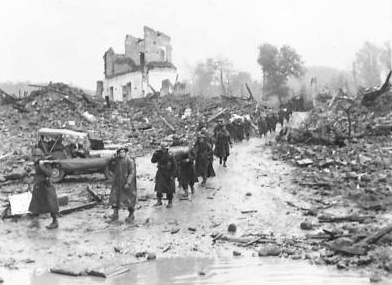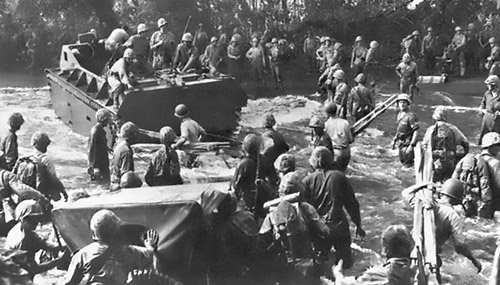I Was There! - Japanese Night-Prowlers Routed in the Solomons
The War Illustrated, Volume 7, No. 173, Page 569, February 4, 1944.
New Zealand and U.S. troops landed on Mono Island (known also as Treasury Island) in the Solomons, S.W. of the Shortland Islands, on October 26, 1943, and were in complete occupation by November 3 – after extraordinary incidents such as related here by a N.Z. Official War Correspondent.
At time a score or more Japanese prowled among our lines and foxholes, chattering among themselves, singing sometimes and conducting themselves with a strangely carefree abandon that suggested a queer twist of psychology, or, what might well have been possible, overindulgence in their alcoholic saki, many bottles of which were found in camp sites.
They sat on fallen trees and felt gingerly for men's heads in foxholes (three coconuts and pieces of coral placed here and there!) and clicked signals to each other with wooden sticks. Four sat for two hours within a yard of a wounded New Zealander, but they never saw him. One poked a skinny hand under the log roof of a big foxhole and was riddled with a tommy-gun burst.
There were occasional interchanges of fire through one night, but no enemy were killed. Four lay dead after the second night. It turned out that they had a purpose, for from trees along the beach came snipers' fire and on the following day at least nine snipers were found. They had been eliminated by spraying the tree tops with bullets.
One battalion has this story about “The Corpse that Walked”, which has the testimony of the commanding officer as a guarantee of veracity. Late one afternoon there were shots from tree-tops and coconut palms which whizzed close to a private's head. He turned his automatic rifle into a palm, and was rewarded by the falling of a sniper's rifle and the slumping of a barely discernible body amongst the greenery. The Japanese had been tied to the tree and the body stayed where it was. Dusk was falling and the body was left alone. In the morning it was gone.
Referring to another night incident, a South Island corporal now knows what it feels like to have his steel helmet lifted slowly back while he slept in a foxhole. He woke to semi-consciousness one night as his hat was being pulled gently upwards. Not realizing what was happening he drowsily pulled it back on his head. Next moment a hand jerked it up again, and the truth then dawned upon the corporal that someone was trying to lift his chin and expose his throat. The corporal did not drowse any more. He lashed out with his fists, and a dark form slid off in a hurry. With this blood-curdling lesson of night-risks in mind it is perhaps needless to record that the corporal slept no more that night, nor the night after!
Previous and next article from I Was There!
I Was There! - Men, Mules and Mud I Saw on Monte Camino
One of the key heights on the road to Rome, Monte Camino enemy positions were broken into by the 5th Army by December 7, 1943. War Correspondent Alexander Clifford described appalling conditions maste
I Was There! - At Cape Gloucester We Crashed Our Way Ashore
Covered by Australian and American naval units, U.S. troops effected a landing at Cape Gloucester, New Britain, on December 26, 1943. Operations were witnessed by Kenneth Slessor, Australian Official
Index
Previous article
The War in the Air
It might at first sight appear that the entirely naval action in which the Scharnhorst was sunk off the North Cape (see pp. 518-520) was an incident in the war so completely maritime as to refute by i
Next article
I Was There! - At Cape Gloucester We Crashed Our Way Ashore
Covered by Australian and American naval units, U.S. troops effected a landing at Cape Gloucester, New Britain, on December 26, 1943. Operations were witnessed by Kenneth Slessor, Australian Official





